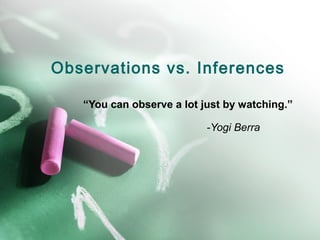Identifying Problems from Observations
•Download as PPT, PDF•
9 likes•35,510 views
Report
Share
Report
Share

Recommended
Recommended
More Related Content
What's hot
What's hot (20)
SPORE AND CONE BEARING PLANTS, VEGETATIVE PROPAGATION

SPORE AND CONE BEARING PLANTS, VEGETATIVE PROPAGATION
Recognizing Useful and Harmful Materials Day 1.pptx

Recognizing Useful and Harmful Materials Day 1.pptx
Similar to Identifying Problems from Observations
Similar to Identifying Problems from Observations (20)
Mystery footprints observationinference_9.12.12.pp

Mystery footprints observationinference_9.12.12.pp
The scientific method and experimental design 9th grade biology

The scientific method and experimental design 9th grade biology
Recently uploaded
Recently uploaded (20)
Cloud Frontiers: A Deep Dive into Serverless Spatial Data and FME

Cloud Frontiers: A Deep Dive into Serverless Spatial Data and FME
WSO2's API Vision: Unifying Control, Empowering Developers

WSO2's API Vision: Unifying Control, Empowering Developers
JavaScript Usage Statistics 2024 - The Ultimate Guide

JavaScript Usage Statistics 2024 - The Ultimate Guide
Why Teams call analytics are critical to your entire business

Why Teams call analytics are critical to your entire business
Navigating Identity and Access Management in the Modern Enterprise

Navigating Identity and Access Management in the Modern Enterprise
WSO2 Micro Integrator for Enterprise Integration in a Decentralized, Microser...

WSO2 Micro Integrator for Enterprise Integration in a Decentralized, Microser...
Elevate Developer Efficiency & build GenAI Application with Amazon Q

Elevate Developer Efficiency & build GenAI Application with Amazon Q
Vector Search -An Introduction in Oracle Database 23ai.pptx

Vector Search -An Introduction in Oracle Database 23ai.pptx
Repurposing LNG terminals for Hydrogen Ammonia: Feasibility and Cost Saving

Repurposing LNG terminals for Hydrogen Ammonia: Feasibility and Cost Saving
DEV meet-up UiPath Document Understanding May 7 2024 Amsterdam

DEV meet-up UiPath Document Understanding May 7 2024 Amsterdam
How to Check CNIC Information Online with Pakdata cf

How to Check CNIC Information Online with Pakdata cf
Decarbonising Commercial Real Estate: The Role of Operational Performance

Decarbonising Commercial Real Estate: The Role of Operational Performance
Identifying Problems from Observations
- 1. Observations vs. Inferences “You can observe a lot just by watching.” -Yogi Berra
- 2. Observations • An observation is the gathering of information by using our five senses: Sight Smell Hearing Taste Touch • There are two types of observations Qualitative Quantitative
- 3. Qualitative Observations • Qualitative observations describe what we observe. • “Qualitative” = quality (descriptive) • These observations use adjectives to describe something. • Example: The flower has white petals. • Example: Mr. M has blue eyes.
- 4. Quantitative Observations • Quantitative observations measure what we observe. • “Quantitative” = quantity (numerical) • These observations use numbers to measure something in a quantitative way. • Example: The flower has seven petals. • Example: Mr. M has two eyes.
- 5. Which is better? • Both types of observations are valuable in science. In an experiment though, quantitative observations can be precisely and objectively compared. Qualitative: The road is long. (describes) Quantitative: The road is 5 km long. (measures) • Some things are easier to quantify than others. Scientists use innovative ways of turning qualitative into quantitative.
- 6. Which is better? • For example, someone might say that a dead fish is smelly. • It is hard to know just how smelly the fish is though. • To make this quantitative, the scientist could ask the person to rate the “smelliness” on a scale of 1-5. • This would then allow you to compare how smelly the fish is!
- 7. Inferences • Inferences are an explanation for an observation you have made. • They are based on your past experiences and prior knowledge. • Inferences are often changed when new observations are made. • Again, observations are information we gather directly through our five senses….inferences help explain those observations!
- 8. Here are some examples! • Observation: The grass on the school’s front lawn is wet. • Possible inferences: It rained. The sprinkler was on. There is dew on the grass from the morning. A dog urinated on the grass! • All of these inferences could possibly explain why the grass is wet. They are all based on prior experiences. We have all seen rain, sprinklers, morning dew, and dogs going to the bathroom.
- 9. Here are some examples! • Observation: The school fire alarm is going off. • Possible inferences: The school is on fire. We are having a fire drill. A student pulled the fire alarm. • Again, these are all logical explanations for why the fire alarm is going off.
- 10. Last one! • Observation: A student is sitting in the main office. • Possible inferences: ? Why might a student be sitting there?